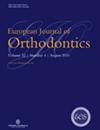遗传和环境对面部软组织轮廓发育的影响:一项双胞胎研究
IF 2.7
3区 医学
Q1 DENTISTRY, ORAL SURGERY & MEDICINE
引用次数: 0
摘要
目的 本研究旨在确定遗传和环境因素在混合牙列和恒牙列阶段面部软组织轮廓表型变异中的相对作用。方法 在这项回顾性队列研究中,我们从阿德莱德牙科学校的档案记录中获得了 139 对双胞胎(55 对单卵双胞胎和 84 对双卵双胞胎)的标准化面部轮廓照片。照片分析使用了从混合牙(7-11 岁)到恒牙(12-17 岁)阶段的 12 个角度和 14 个线性面部轮廓测量值。根据双胞胎模型的正常假设,使用单变量结构方程模型进行了遗传分析。结果 在混合牙列阶段,遗传加独特环境模型(AE 模型)在解释所有 26 个面部特征的表型变异方面最为简洁,其狭义遗传率估计值介于 0.38 和 0.79 之间。在恒牙列中,AE 模型对 26 个性状中的 20 个性状的解释最为合理,然而,有 6 个性状的变异,尤其是面部下三分之一的性状,最好由共同环境因素和独特环境因素来解释。局限性 本研究仅包括欧洲血统的双胞胎。结论 面部软组织特征显示了遗传和环境的动态影响,在混合牙列和恒牙列的早期阶段,遗传的叠加影响更大。然而,有证据表明,在恒牙列的早期阶段,环境对面部下三分之一的影响越来越大。本文章由计算机程序翻译,如有差异,请以英文原文为准。
Genetic and environmental contributions to the development of soft tissue facial profile: a twin study
Objectives This study aimed to determine the relative contribution of genetic and environmental factors in the phenotypic variation of the soft tissue facial profile during the mixed dentition and the permanent dentition stages. Methods In this retrospective cohort study, standardized facial profile photographs of 139 twin pairs (55 monozygotic and 84 dizygotic) were obtained from archival records at the Adelaide Dental School. Photographic analysis used 12 angular and 14 linear facial profile measurements from the mixed dentition (7–11 years) to the permanent dentition (12–17 years) stages. A genetic analysis was performed using a univariate structural equation model adhering to the normal assumptions of a twin model. Results In the mixed dentition stage, the additive genetic (A) and unique environment (E) model, AE model, was the most parsimonious in explaining the observed phenotypic variance for all 26 facial traits with the narrow-sense heritability estimates ranging between 0.38 and 0.79. In the permanent dentition, the AE model was the most parsimonious for 20 out of 26 traits, however, the variance of six traits, particularly those in the lower third of the face, was best explained by the shared environmental and unique environmental factors. Limitations This study exclusively included twins of European ancestry. Conclusions The soft tissue facial profile demonstrated dynamic genetic and environmental influences with a greater additive genetic influence during the mixed dentition and the early stages of the permanent dentition. However, there was evidence of increasing environmental influence in the lower third of the face during the early stages of the permanent dentition.
求助全文
通过发布文献求助,成功后即可免费获取论文全文。
去求助
来源期刊

European journal of orthodontics
医学-牙科与口腔外科
CiteScore
5.50
自引率
7.70%
发文量
71
审稿时长
4-8 weeks
期刊介绍:
The European Journal of Orthodontics publishes papers of excellence on all aspects of orthodontics including craniofacial development and growth. The emphasis of the journal is on full research papers. Succinct and carefully prepared papers are favoured in terms of impact as well as readability.
 求助内容:
求助内容: 应助结果提醒方式:
应助结果提醒方式:


